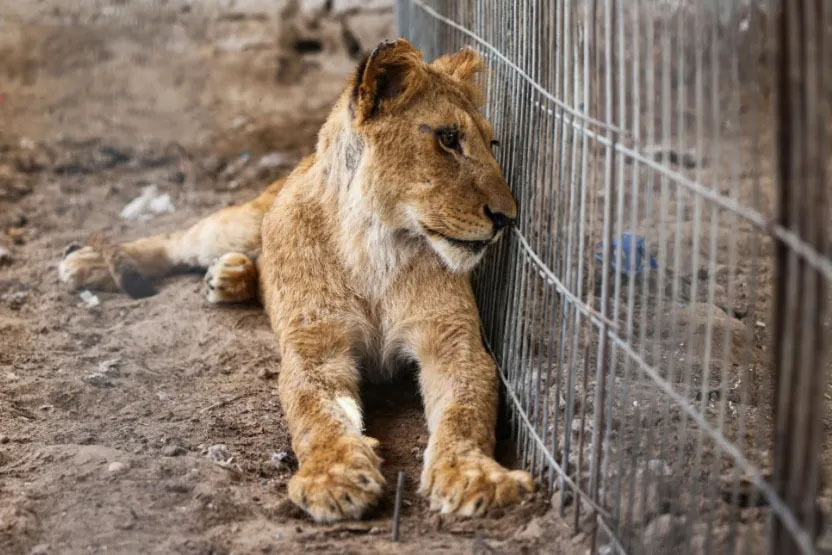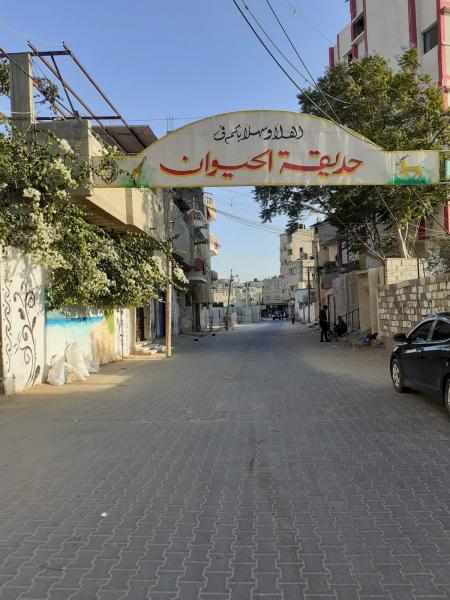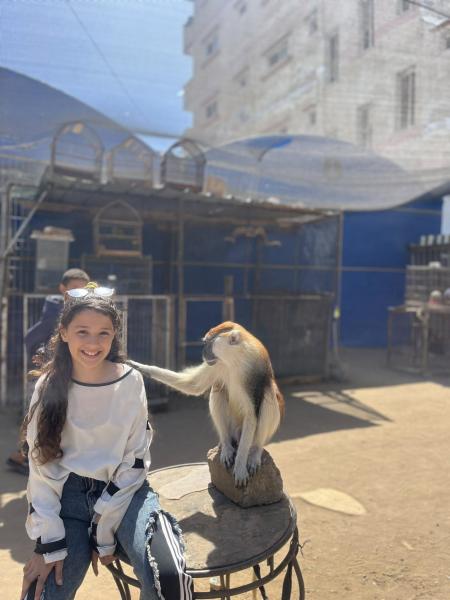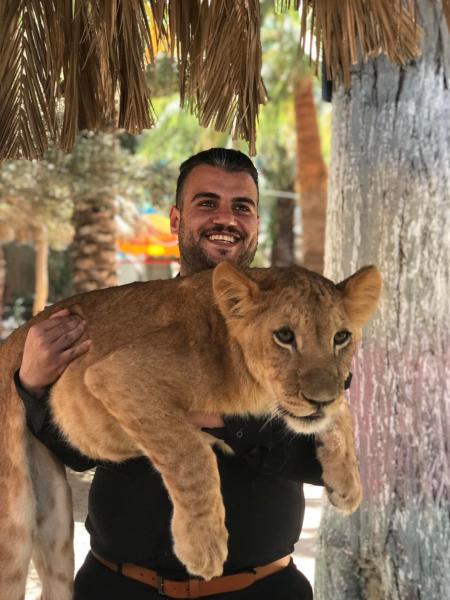21 May 2025

Tired Earth
By The Editorial Board
The animals endure constant bombing and suffer from severe shortages of food and veterinary care.

Written by Hadeel Farhat of the Institute for Palestine Studies
In the heart of the Gaza Strip, brutal bombardment continues to destroy every aspect of life. The land groans under the weight of ongoing devastation and famine. Amid the ruins, yet another chapter of tragedy is unfolding. Israel's genocidal campaign has spared no one -- not even animals, left to face death in silence in abandoned zoos.
According to the director of Public Relations at the Gaza Municipality, Asem al-Nabih, a 2023 census showed that Gaza was once home to 19 zoos, housing 100 exotic or wild animals, including lions and eagles.[1] Today, nearly all of these zoos have been completely destroyed. The animals endure constant bombing and suffer from severe shortages of food and veterinary care. Many have been left behind after their caretakers were killed. In this way, the animals have become inadvertent witnesses to the magnitude of disaster in Gaza. Trapped in their cages, they fall to the bottom of the priority list for rescue crews, as the struggle to save human lives grows more desperate. The scenes unfolding in these zoos are layered in grief—reflecting not only the suffering of the animals but also the loss of those who once cared for them.
Gaza's Zoos Under Fire
According to a report by the Gaza Municipality, the Zeitoun Neighborhood Zoo once housed a variety of animals and birds, including lions and eagles. Heavy bombardment has since turned it into something more akin to a cemetery.

Rafah Zoo Facebook Page, July 19 2022
Raed Lubbad, the director of the Parks Department at the Gaza Municipality, stated that despite repeated efforts to rescue the remaining trapped animals, Israeli forces prevented municipal crews from reaching the zoo.[2] Lubbad recounted that during one such attempt to deliver food and medicine, the crew was directly targeted by an Israeli reconnaissance drone, forcing them to retreat to save their own lives. He emphasized that this attack constitutes a flagrant violation of the principles of humanitarian work.
Lubbad stated that most of the animals died of starvation or were buried under rubble. The few that survived are without food or care, trapped in an environment of pollution and destruction. He added that the worsening security situation has made it impossible to access the park or assess the full extent of the losses. However, recent aerial images reveal severe environmental and infrastructural damage.
According to the Gaza Municipality, the zoos' infrastructure—including cages, shelters, and food stores— has been completely destroyed by the bombings. With the municipality's logistical and financial capacities in total collapse, reconstruction is now nearly impossible.
Although some zoo owners in southern Gaza were able to rescue a number or animals and relocate them to safer locations, these animals are now suffering from severe behavioral and psychological distress caused by the constant sound of shelling., Many also suffer from physical injuries and serious illnesses resulting from malnutrition and deteriorating conditions in temporary shelters.
The Gaza Municipality has made an urgent appeal for immediate international intervention to provide basic relief for the remaining animals, including food, water, and veterinary care. It has also called for support for efforts to rehabilitate the devastated zoos.[3]
Exodus with the Animals: Escaping a Living Hell
In an interview, Fathi Jumaa, the owner of the Rafah Zoo, shared his own experience, offering a powerful account of the tragedy unfolding in Gaza—one that affects both humans and animals and reveals the crisis's deep, multifaceted nature.[4]

Rafah Zoo Facebook Page, April 21, 2025
After Israeli forces designated Rafah as an unsafe zone amid ongoing bombardment, Jumaa was forced to flee to central Gaza. He made the journey with what little hope he had left, in a scene that felt like an escape from hell. With the bombing intensifying, the situation on the ground deteriorating, and transportation costs soaring, Jumaa had to make one of the most painful decisions of his life: to leave behind more than half of his zoo animals—including a lion and a lioness—trembling with fear and hunger behind their bars. In abandoning them, he felt he had left behind a piece of his own soul. He did what he could, rescuing the few animals he was able to take, including three lion cubs born in the midst of war, which he carried in his arms.
Despite making three perilous attempts to return and evacuate the animals, Jumaa's efforts were in vain. As with the Zeitoun Zoo, some animals were killed in the bombings, others died of hunger, and the few that survived were left clinging to life in desperate conditions.
During the ceasefire, Jumaa made one final, desperate attempt to return to Rafah to check on his animals. But when he arrived, they were gone —missing without a trace. “I found no sign of them,” Jumaa said. “Not even their skeletons. That confirmed my suspicion that the Israeli forces had taken them.”
Today, Jumaa cares for the three lion cubs in a rented space in central Gaza, which costs him $1,000 a month. Amid severe food shortages and soaring prices, he also spends between $300 and $500 on donkeys and horses to feed the animals.
Jumaa's losses extended beyond the lions. Before the war, he owned four eagles. One became increasingly aggressive due to fear and starvation, forcing him to release it. Two others were killed in the bombings, leaving only one struggling to survive. Among the few animals he managed to take with him during his displacement was a snake. Though it survived the airstrikes, it eventually died from hunger and malnutrition—yet another silent victim of the war.
Collapse of Veterinary Care: Gaza's Animals Between Hunger and Disease
Dr. Bashar Shehadeh, a veterinarian working with the Gaza Municipality, expressed deep concern in an interview about the dire conditions facing animals in Gaza—particularly predatory animals, which require specialized nutritional and medical care.[5]
Shehadeh said, “We have lost large numbers of animals in the Gaza Strip, and the rest are on the brink of death due to the worsening health and living conditions.” He noted that the prices of veterinary medicines and animal feed have skyrocketed, increasing by 300% compared to pre-war levels. This has forced teams to rely on whatever medications are available as a last resort to try to save some cases.
In the absence of basic food sources, some zoo owners have resorted to feeding their animals canned fish, such as tuna and sardines. However, these products contain high levels of mercury and are not suitable for animal consumption, leading to widespread cases of mercury poisoning. At the start of the war, some attempted to use bread as an emergency food source, but this quickly became unsustainable when the price of a single bag of flour soared to $300.
Shehadeh notes that the dire economic situation has forced many people to abandon their animals—both domestic and wild—as the cost of care has become an unsustainable burden.
One of the more painful recent developments is the sharp rise in requests for animal sterilization—procedures usually performed to prevent reproduction. Shehadeh explains that this trend reflects a desperate attempt to reduce the financial burden of feeding pets. Under normal conditions, performing such operations on zoo animals is already complex. But despite the urgent need, the lack of anesthesia equipment and specialized surgical medications has made these procedures impossible in Gaza.
Another veterinarian, Dr. Muhammad Al-Bayoumi, described the current environmental and health situation as catastrophic.[6] Approximately 90% of veterinary clinics have been completely destroyed, and by mid-2024, nearly 80% of the veterinary medicine supply had been depleted—leaving thousands of animals without access to medical care.
“The animals that survived the bombing did not survive the hunger,” Al-Bayoumi said—a stark summary of the grim reality. He cited the spread of diseases such as gum infections, digestive issues, skin parasites, and viral infections, all fueled by malnutrition, unclean water, and unsanitary conditions. Al-Bayoumi warned that some of these illnesses—particularly those transmitted through direct contact, like skin parasites—could spread to humans, especially given the overcrowded shelters and lack of healthcare resources. This, he said, could trigger a broader health crisis in a society already besieged and exhausted.

Rafah Zoo Facebook Page, September 27, 2023
Shelter Under Fire: The Story of the Sulala Animal Rescue
Amid the widespread destruction, Saeed Al-Err of the Sulala Animal Rescue Center in Gaza shared a similarly tragic account.[7] Before the genocide began, his center cared for 600 dogs. Most were killed in the Israeli bombardment; others suffered fractures and amputations, while the rest eventually died of starvation.
In the early days, the center received numerous calls about missing animals, but the communications breakdown and ongoing displacement made it nearly impossible to respond. Of the original 600 dogs, only 40 could be kept—10 of them requiring special care. Now, renewed bombardment has once again forced Al-Err and his team to flee, leaving the dogs behind after providing what little food and water they could.
“We tried to return, but the famine and intensified bombing have made it impossible to reach the shelter,” Al-Err said, his voice heavy with anguish. “The fate of the dogs remains unknown. What little hope we had fades with each new airstrike.”
In Gaza, there are no lion roars or the beating of eagles' wings—only the faint moans of animals staring out from shattered cages, waiting for a slow death or a miracle that never comes.
Under the relentless bombardment that has decimated Gaza and leveled its infrastructure, these creatures have become the forgotten victims—left to struggle alone with hunger, fear, and abandonment. This is no longer just about saving animals; it is about the sheer impossibility of sustaining life on a land ravaged by siege and death.
[1] Asem Al-Nabih, Director of Public Relations at the Gaza Municipality.
[2] Interview with Raed Labad, April 30, 2025.
[3] Interview with Raed Labad, Gaza Municipality, April 30, 2025.
[4] Interview with Fathi Jumaa, owner of a zoo in Rafah, April 23, 2025.
[5] Interview with veterinarian Bashar Shehadeh, April 30, 2025.
[6] Interview with veterinarian Muhammad Al-Bayoumi, April 23, 2025.
[7] Interview with Saed Al-Arr from the Silah Animal Welfare Foundation, April 23, 2025.
Source : Institute for Palestine Studies
Comment
Reply